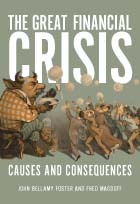
BOOK REVIEW
‘The Great Financial Crisis: Causes and Consequences’
By John Bellamy Foster and Fred Magdoff
Monthly Review Press, 2009, 160 pages
The economic collapse spreading through the world is being blamed on greedy American bankers who peddled sub-prime loans to people with risky credit histories. John Bellamy Foster and Fred Magdoff, authors of “The Great Financial Crisis: Causes and Consequences”, disagree.
They argue that the sub-prime loan debacle is merely an underlying symptom, rather than a principal cause of the crisis. The main cause of the present crisis is the tendency of mature capitalist economies towards stagnation.
Building on the works of Marxist economists Paul Sweezy, Paul Baran and Harry Magdoff, Foster and Magdoff define stagnation as a state where economies operate far below their potential in terms of production with high unemployment/underemployment. Stagnation is the normal state of mature capitalism rather than rapid growth. The main growth engine in advanced capitalist countries such as the US, Japan, Canada and western Europe, as well as developing capitalist countries have become speculative bubbles, fueled by massive consumer, government and corporate debt.
The main reasons for stagnation are: the development and maturation of industry; the absence of new technologies that generate epoch making, profound transformations of the economy, such as with the introduction of the car; growing inequality in the distribution of wealth and income which undermines working class consumption, leading to reduced investment as unused industrial capacity mounts and the wealthy speculate more instead of investing in the real economy; monopolization which undermines price competition.
The golden age of capitalism, lasting from 1950 to 1969, came to end by the 1970s and sources of profitable investment opportunities dried up in the real economy producing goods and services. Economic growth rates and corporate profits declined and unemployment increased. Business’s attempt to restore profitability by reducing wages failed. High Military spending and the sales effort were not enough to revive growth.
Corporations and wealthy investors turned to the finance industry, “as capital sought to leverage its way out of the problem by expanding debt and gaining speculative profits”, write the authors. The industry grew, offering more exotic financial products based on speculation and gambling. Finance differs from the real economy in that it does not produce real goods, services or many jobs. Most money invested in the stock market is not used to expand production. Economist John Maynard Keynes suggested that the stock market is primarily a product of investors trying to reduce their risks investing in real production. Money making through speculation has increasingly displaced production of goods and services.
The current housing market collapse in North America is simply the latest speculative bubble that has burst, generated by capitalism’s stagnation tendencies. When the stock market bubble crashed in 2000, the Clinton administration lowered US interest rates, staving off a deep recession. The availability of cheap money meant that households were able to increase borrowing on homes, cars and credit cards, spurring economic growth and hyper-speculation. The combination of low interest rates and longer mortgages resulted in affordable monthly payments, despite soaring housing prices. Huge amounts of capital flowed into the real estate market. The banks gave sub-prime loans to the poor to buy houses with initially low teaser interest rates and convinced them that soaring housing prices would allow them to refinance their mortgages once the teaser rates expired.
The banks packaged these loans together into securities and sold them to US and international investors, banks and hedge funds. In 2006, the US housing bubble began to deflate after the government raised interest rates, leading to falling housing prices and a wave of defaults.
US and international investors and the finance industry, who had borrowed and speculated heavily in mortgage backed securities, found that they were holding worthless assets, leading to panic selling and a credit crunch. Heavily indebted US consumers cut spending, triggering a world wide recession.
These speculative bubbles based on debt, unable to produce rapid economic advance for any length of time, lead to recurring crises when they burst, according to Foster and Magdoff. After each bubble explodes, greater amounts of debt are needed to stimulate growth. US consumer, corporate and government debt loads have increased dramatically over the last 30 years.
Japan, whose stock market and real estate bubbles burst in the late 80s and early 1990s, has been mired in stagnation ever since, despite numerous attempts to stimulate the economy through massive government spending on infrastructure.
The authors argue that the developed and developing capitalist countries now face a long period of recession or depression followed by stagnation, characterized by at the best minimal growth and high unemployment. Deflation, marked by falling housing and consumer goods prices, is the newest danger, threatening further production cuts and layoffs.
Bailing out the US banking system, as the Obama administration proposes, will not resolve the problem. The only solution is to replace capitalism with socialism, where there is a massive redistribution of wealth and income and the economy is geared towards meeting social needs, state the authors.
Written in simple, clear language that an average reader can understand, ‘The Great Financial Crisis’ offers a concise, well documented analysis of the current world wide economic downturn and what needs to be done to overcome the crisis.
Tim Pelzer is a Canadian journalist who writes frequently on international issues.











Comments